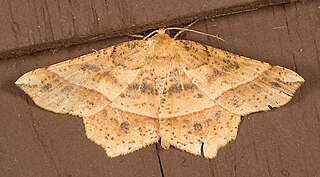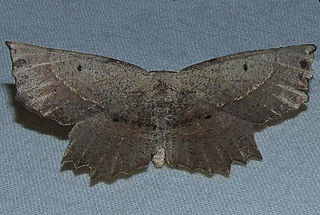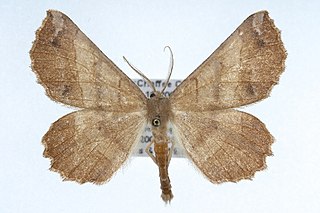
The Angeronini are a small tribe of geometer moths in the subfamily Ennominae. The tribe was first described by William Trowbridge Merrifield Forbes in 1948. As numerous ennomine genera have not yet been assigned to a tribe, the genus list is preliminary.

Euchlaena is a genus of moths in the family Geometridae erected by Jacob Hübner in 1823.

Euchlaena tigrinaria, the mottled euchlaena, is a moth of the family Geometridae. The species was first described by Achille Guenée in 1857. It is found from New Brunswick to Virginia, west to Texas, Utah and Oregon, north to British Columbia.
The Cytodeme is the total assembly of organisms that use an identical suite of chromosomes to carry their genes. The term was first printed in the 1950s in a book by Heslop-Harrison. Discussing the Deme Terminology - he continued "cytodeme, a population differing in some distinctive cytological feature from others." In most cases the suite is composed of several pairs of homologous chromosomes with or without a pair of sex chromosomes. Since the only acceptable proof of the identity (homology) of chromosomes lies in their ability to pair fully from end to end during meiosis it follows that:
- In asexual taxa membership of a cytodeme can only be presumed on such evidence as visual similarity of chromosomal ideotype, but never proved.
- In sexual taxa all of the members of one cytodeme are fully intercompatible yielding the fertile progeny which proves their membership.

Euchlaena obtusaria, the obtuse euchlaena moth, is a moth of the family Geometridae. The species was first described by Jacob Hübner in 1813. It is found in North America, where it has been recorded from Alberta east to Nova Scotia, south to Florida and Texas. The habitat consists of mixed wood forests.

Euchlaena deplanaria is a species of moth of the family Geometridae. It is found in North America, where it has been recorded from Colorado to Massachusetts and south to Florida and Texas.

Euchlaena marginaria, the ochre euchlaena moth, is a moth of the family Geometridae. The species was first described by Charles Sedgwick Minot in 1869. It is found in North America, where it has been recorded from south-central British Columbia and Idaho to Nova Scotia and south to Florida and Missouri.

Euchlaena deductaria, the forked euchlaena moth, is a species of moth of the family Geometridae. It is found in North America, where it has been recorded from Alabama, Arkansas, Florida, Georgia, Kentucky, Maine, Maryland, New York, North Carolina, Ohio, Oklahoma, South Carolina, Tennessee, Texas and West Virginia.

Euchlaena muzaria, the muzaria euchlaena moth, is a species of moth of the family Geometridae. It is found in North America, where it has been recorded from Florida, Kentucky, Maine, Maryland, Massachusetts, Minnesota, New Brunswick, New Hampshire, New York, North Carolina, Ohio, Ontario, South Carolina and Tennessee.

Euchlaena johnsonaria, or Johnson's euchlaena moth, is a moth of the family Geometridae. The species was first described by Asa Fitch in 1870. It is found in North America, where it has been recorded from southern coastal British Columbia east to Nova Scotia, south to New Jersey, Missouri and Oregon. The habitat consists of deciduous wooded areas.

Euchlaena madusaria, the scrub euchlaena moth, is a species of moth of the family Geometridae. It is found in North America, where it has been recorded from British Columbia, east to Nova Scotia, south to Florida, Missouri and Oregon. The habitat consists of dry woodlands. The species is listed as threatened in Connecticut.

Euchlaena mollisaria is a species of moth of the family Geometridae. It is found in North America, where it has been recorded from southern California to Colorado, north to Montana and British Columbia.

Euchlaena irraria, commonly known as the least-marked euchlaena, is a species of moth in the family Geometridae. It was first described by William Barnes and James Halliday McDunnough in 1916 and it is found in North America.
This page is based on this
Wikipedia article Text is available under the
CC BY-SA 4.0 license; additional terms may apply.
Images, videos and audio are available under their respective licenses.











